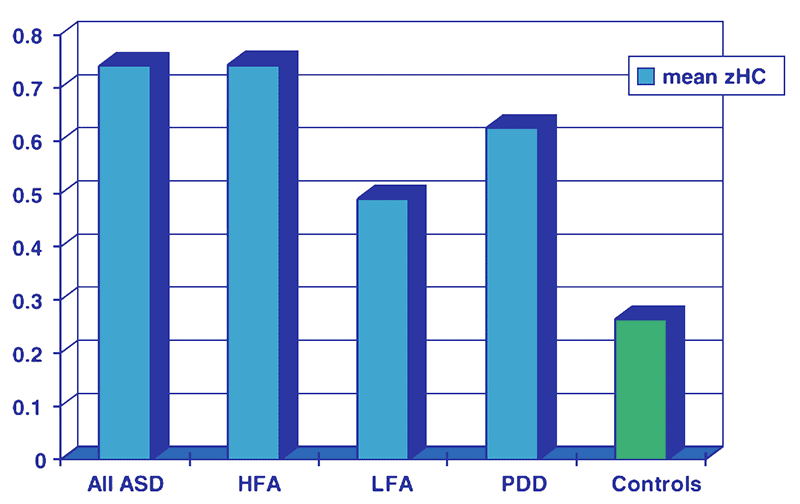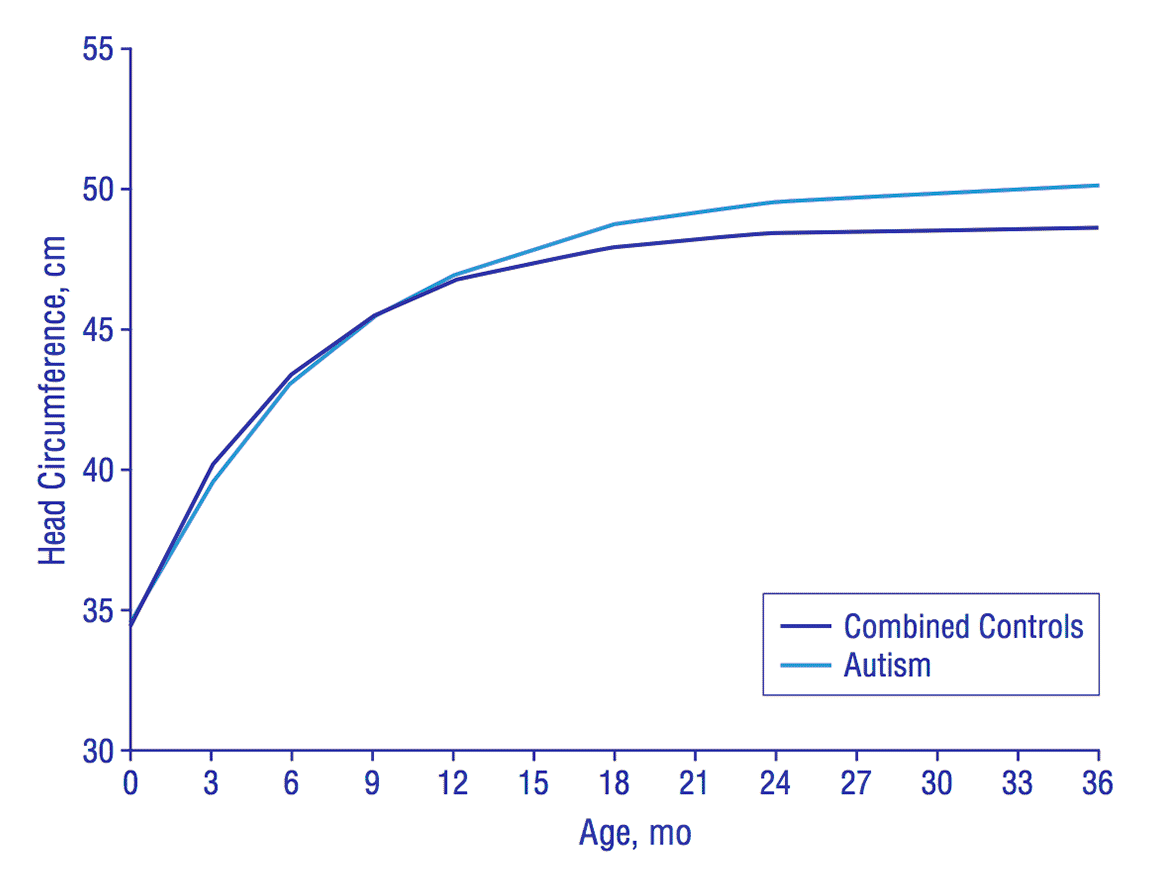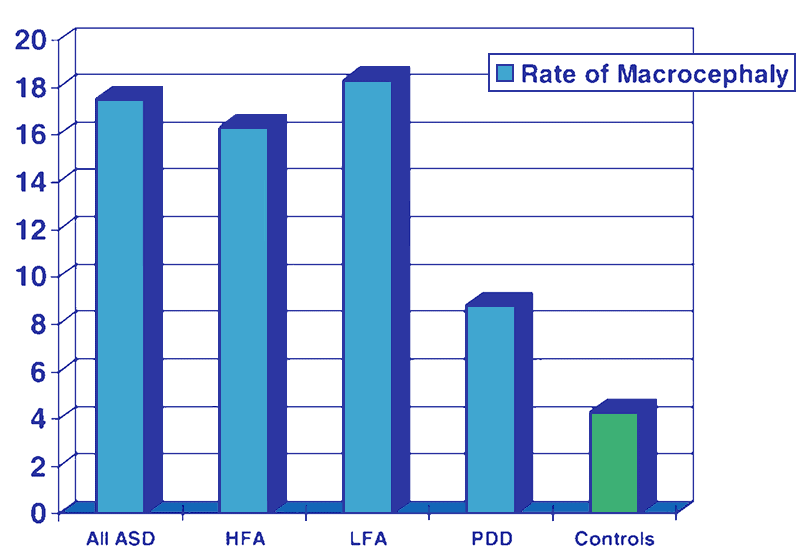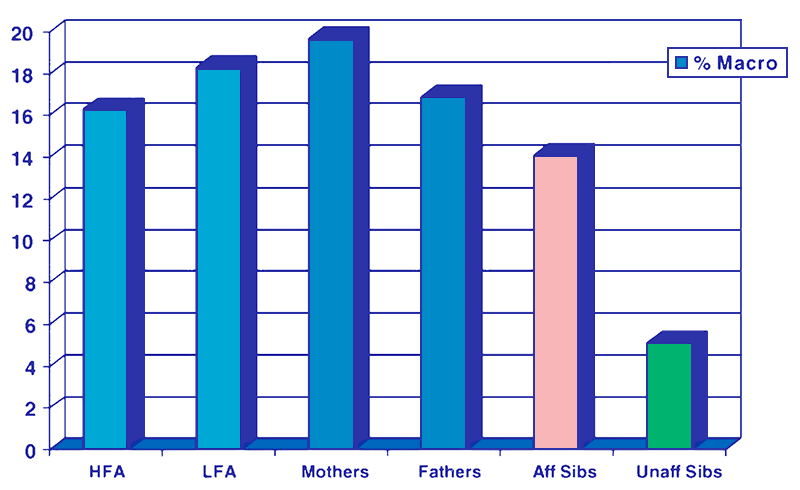In the next post in the series, we will have a look at the anatomical differences of the autistic brain compared to the neurotypical brain. But before we do that, let’s have a look at that flesh crown around the brain.
This is the kind of research you are probably not going to like. But let’s not bury our enlarged heads in the sand now. The amount of earth my head alone displaces might yield a magnitude of 5 or above on the Richter magnitude scale.
Head circumference
A study from 2006 found that the head circumference of autistic children tends to be large relative to their height.[1]Head circumference and height in autism: A study by the collaborative program of excellence in autism
In the diagram below, you can see how various subtypes of autism all have larger heads relative to height compared with controls, and in particular, those previously classified as high-functioning autism and PDD-NOS.
Head circumference & height in autism

- A proband is a subject of study (a person for instance) serving as the starting point for the genetic study of a family (used especially in medicine and psychiatry).
Natalie and I belong to the group that shows the most enlarged heads on average. I might have a skewed sense of perception, but I don’t think our heads are that large. I am quite tall, however, so I may have one of the larger heads that appears approximately normal given my length. But between you and me, Natalie’s head does border on bobble-size.
A different study from 2005 that looked at the head circumference and brain size in autism yielded some interesting findings that I will cover in upcoming posts in this series on autistic brain differences, but for now, have a look at the growth trajectory of the head circumference of autistics and controls in the diagram below.[2]Magnetic Resonance Imaging and Head Circumference Study of Brain Size in Autism
Head circumference growth trajectory

This is also to illustrate that different independent studies are finding that the heads of autistic children tended to be greater than average, at least from 1–3 years old.
Macrocephaly
Besides greater head circumference on average, the study from 2006 also found that the mean, variance, and rate of macrocephaly is increased in children with autism.[3]Head circumference and height in autism: A study by the collaborative program of excellence in autism
“What is macrocephaly?”, you might ask. It is a condition in which the head is “abnormally” large. In other words, a medical term for larger than normal heads. The macrocephaly diagnosis applies when the head circumference is 2 deviations above the mean for age and sex.
In the diagram below you can see the rate of macrocephaly in percentage for various subtypes of autism, and controls.
Macrocephaly rate in autism

Macrocephaly was found to be associated with delayed onset of language, in particular meaningful use of single words, which is a key index of onset of language.[4]Head circumference and height in autism: A study by the collaborative program of excellence in autism
Prevalence
Absolute or relative macrocephaly was present in 22.6% of the 208 autism subjects.[5]Head circumference and height in autism: A study by the collaborative program of excellence in autism
- The rate of absolute macrocephaly (i.e., a head circumference z-score of 1.88+ standard deviations above the mean, regardless of height) was found to be 18.6% compared to 4.3% in neurotypicals.
- The rate of relative macrocephaly (i.e. a head circumference z-score of 2+ standard deviations greater than standardized height) was found to be 29.8% compared to 6.7% in neurotypicals.
Also, the rate of microcephaly (a condition where the head circumference is smaller than normal) was found to be low in the autism sample (3.8%).[6]Head circumference and height in autism: A study by the collaborative program of excellence in autism
Although I could not find firm figures on the prevalence of macrocephaly in the general population, since macrocephaly is defined as a head circumference of two or more deviations above the mean which equates to the 97th percentile,[7]Textbook of Pediatric Care – Chapter 176: Macrocephaly the prevalence of macrocephaly ought to be 3%. To my own amusement, this must mean that a macrocephaly epidemic is not possible, because macrocephaly will always be defined in relative terms; if human heads double in size on average, this will greatly affect the mean, and those with a head circumference of two or more deviations above the doubled head size will now be considered to have macrocephaly.
A different study from 2000 found a macrocephaly rate of 12.2% in autistic subjects, and 15.5% in their first-degree relatives.[8]Macrocephaly in autism and other pervasive developmental disorders
Autism families
In addition to autism itself, standardized height and average parental head circumference were the most important factors predicting head circumference in individuals with autism.[9]Head circumference and height in autism: A study by the collaborative program of excellence in autism
In other words, the taller you are, the larger your head; but also, the larger your parents’ heads, the larger your head is likely to be. Seems logical.
Head circumference in autism families

Scientists found that parents of autistic children were more likely to have an increased head circumference—some of them meeting criteria for macrocephaly as well.[10]Head circumference and height in autism: A study by the collaborative program of excellence in autism
Mean head circumference and rate of macrocephaly are increased in the parents of autism probands with and without macrocephaly.
So it seems that in some families, both autism and increased head circumference runs in the genes.
In my family, I have not observed a disproportionally large head circumference to be a particular feature. However, my brother—an intelligent fella who may or may not have broad autism phenotype—does have a fairly impressive head, which looked particularly on the large side when he was a toddler. It didn’t help that he had curls, as his hair only added to the cranial volume!
Social challenges
If an enlarged head is deemed to be an issue at all, it is likely aesthetic rather than functional. And really, the connotations of an enlarged head can be both negative and positive, as some might expect a larger head to imply a larger brain, which might—erroneously or not—imply higher intelligence.
On the downside, the larger the head size, the greater the challenges in the social domain; increased head circumference was found to be associated with a higher ADI-R social algorithm score.[11]Head circumference and height in autism: A study by the collaborative program of excellence in autism The Autism Diagnostic Interview-Revised (ADI-R) is an investigator-based parent interview about the individual’s early childhood and current social and communication development and stereotyped, repetitive behaviors and interests. The higher the score in any particular domain, the greater the challenges.
So a larger head was associated with more challenges in the social domain. This is quite interesting, because it’s not having a thicker skull or skin that would have any effect on cognition or social behavior, but rather something in the brain. So a larger head may very well mean a larger brain, which means a greater neural network to navigate. And as you might have read in Autistic brain differences pt. 1 – Connectivity, the autistic brain has more short-distance connections and fewer long-distance connections, which alters higher order social and emotional processing and communication.
With a larger head and a larger brain, there is an inherent potential for certain cognitive abilities, but also more short-distance connections, which can actually undermine the level of functioning as it becomes more difficult to engage with neurotypicals in a way that is satisfying to us—and likely either of us.
So we tend to have larger heads. The upside though is that you can fit more brain matter in there.
The downside is that not all of that brain matter is equally conducive to our functioning in a neurotypical world.
But all the same, it is a fascinating brain to navigate. More about that in the next post!
PS: A larger head is not a universal attribute of autism, nor is it exclusive to autism. One cannot diagnose autism based on head size.
Comments
Let us know what you think!